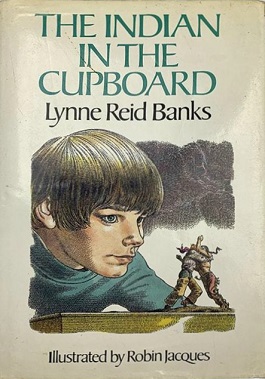The Indian in the Cupboard facts for kids

First edition (UK)
|
|
| Author | Lynne Reid Banks |
|---|---|
| Illustrator | Robin Jacques (UK) Brock Cole (US) |
| Country | United Kingdom |
| Language | English |
| Series | Indian in the Cupboard |
| Genre | Children's fantasy |
| Publisher | J. M. Dent (UK) Doubleday and Company (US) |
|
Publication date
|
1980 |
| ISBN | 978-0-380-60012-0 |
| OCLC | 8878954 |
| Followed by | The Return of the Indian |
The Indian in the Cupboard is a popular children's fantasy novel. It was written by the British author Lynne Reid Banks. The book first came out in 1980. It even became a movie in 1995 called The Indian in the Cupboard.
This book is the first in a series. There are four more books that continue the story: The Return of the Indian (1985), The Secret of the Indian (1989), The Mystery of the Cupboard (1993), and The Key to the Indian (1998). These books are usually recommended for readers aged nine and up.
All the stories are about a young boy named Omri. He finds a special cupboard that has magical powers. When Omri puts plastic toys inside the cupboard and locks it, they come to life! This leads to Omri becoming friends with a tiny, real Iroquois chief from the 18th century named Little Bear. As the series goes on, Omri and his friend Patrick learn more about the cupboard's magic. They discover it can even send people through time.
The book has won many awards. It has been praised by critics for its story. It was even suggested as reading material in some school classes. One review said the first book had a good balance. It showed a child's wish to play with tiny figures. But it also showed that these figures were real people. The New York Times called it "the best novel of the year" in 1981.
Contents
What Happens in the Story?
Omri's Magical Discovery
On Omri’s ninth birthday, his best friend Patrick gives him a small plastic Indian figure. Omri also gets a white metal medicine cupboard from his brother. The only key that fits the cupboard is from Omri's great-grandmother's jewelry box. Omri puts the plastic figure in the cupboard and locks it. The next morning, he finds that the figure has come to life! It is now a three-inch-tall Iroquois man.
This tiny man is named Little Bear (or Little Bull in some versions). At first, he thinks Omri is a god. But he quickly learns that Omri is just a normal, very tall boy. Little Bear then starts telling Omri what to do. Little Bear explores the house and garden. Omri tries to provide everything Little Bear needs.
Learning About Cultures
Little Bear does not like the plastic tipi Omri gives him. This is because Iroquois people live in longhouses, not tipis. This makes Omri learn more about the Iroquois people. He starts to change his ideas about Native Americans. He realizes that Little Bear is a real person with his own history and culture.
Omri is especially sad when a plastic figure of an old Native American chief dies from shock after coming to life. Little Bear, however, takes the old chief's headdress. He is the only one around to take the title. After this, Little Bear becomes even more demanding.
Patrick Joins the Secret
Patrick offers Omri a plastic cowboy figure. He thinks Omri can play with his toy Indian properly now. Omri refuses the gift. This leads to him telling Patrick about the cupboard's secret. Patrick gets very excited. He wants Omri to bring many plastic people to life. Omri argues that these people would be real, not just toys.
But Patrick uses the cupboard without Omri knowing. He brings the plastic cowboy to life. The cowboy is a man named Boone. He is from a completely different time and place than Little Bear. Omri does not want them to meet, but Patrick introduces Boone to Little Bear. The two tiny men do not trust each other from the start. Boone calls Little Bear "savage" and "dirty."
A Dangerous Fight
Things get worse when Omri and Patrick show the tiny men television. Boone cheers when he sees Native Americans being hurt in an old Western movie. Little Bear gets angry and shoots Boone in the chest with an arrow.
Little Bear feels bad right away. But he does not know enough medicine to save Boone. The boys are too big to help. Omri then brings a World War I medic figure to life. This medic is a man named Tommy from the trenches of France. Tommy thinks this is a strange dream. He saves Boone's life before Omri sends him back through the cupboard. Little Bear keeps taking care of Boone's injuries. Slowly, the two tiny men start to trust each other.
This event finally makes Patrick understand. The tiny people are not just toys. Both boys have grown fond of Boone and Little Bear. They agree to send everyone back to their own time.
Saying Goodbye
As a chief, Little Bear asks for a wife. He chooses an Iroquois woman named Bright Stars (or Twin Stars in some editions) from other plastic figures. Omri brings her to life. The two boys and the tiny people have one last celebration. During this time, Boone becomes Little Bear's blood brother. Then, the miniature people are sent home through the cupboard.
Each boy keeps the now-plastic figure of their friend as a reminder. Omri gives the cupboard's key back to his mother. This way, he won't be tempted to bring them back again.

